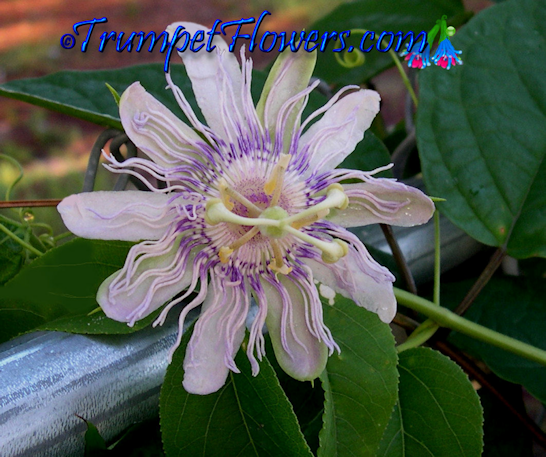Passiflora incarnata, or commonly called the Maypop, is a native to Northern America, and can be found growing wild as far up as Southern Ohio, perhaps beyond. They will die back in these climates come a frost, but bounce back in spring.
Down south, this plant is loved by the Florida state butterfly, the Zebra Longwing. When the passionflower receives some shade in the long, hot afternoons, the butterflies will flock to it and lay their eggs. The strange yet beautiful caterpillars will happily eat the leaves, but will spare the lovely white and lavendar flowers.

The flowers open in early morning, and begin to close as the heat of the day wears on. If it has been pollinated by a bee, butterfly, or you; expect an oblong, egg shaped green fruit to appear. The fruits take about 3 to 4 months to ripen, and are ripe when still green. They gain weight as they get closer to eating. My husband says of all the passion fruits he has tasted, this one is his favorite. The interior will be whitish yellow fleshed, each seed encased in a pulpous, sweet mass of flesh that is delicious either eaten raw or used as a juice. Just run it through a blender, yumm!
Most passionflowers are sporadic about being grown from seed, and p. incasrnata is no exception. The seeds should be used as fresh as possible, and placed in pure vermiculite. Lightly cover with more vermiculite, and place in a sunny, warm location. Fresh seed can come up in as little as a week, or take as long as three months. Mine I plant from my own fresh fruits ususally appear within a week to one month. After the seedlings have their first set of truw leaves, lightly fertilize with a weakened fertlizer.
Passiflora also like being a little bit rootbound, so don't repot even when you see roots coming out the bottom of the pots. This will also help stimulate the vine to grow larger and branch out. When the vine begins to make secondary vines (a vine off the main vine) and you can scratch the main surface and see hairy feeder roots, you can npw repot into a soil-less mixture. Just slightly loosen the rootball, being careful not to break up the interior roots near the plant stem. Spreading vermiculite on the surface of the new pot will help keep down fungus.
They are also picky about being rooted from cuttings, but it is possible. Dipping the cut pieces in a rooting gel contain gibberlic acid helps. Then use a pencil to make a deep hole in a jar theat has been pre-filled with vermiculite and wettened wit rain-water, can help. Cut several, as you will ultimately lose some. Place in a shady, cool location, and the wait begins. It usually takes about 6 to 8 weeks to get them to root.
Allow them to continue to root out, and only when each cutting has many nice, long white roots, should you attempt to transplant them up separately. Keep them in a shady spot a few more weeks, and then slowly adapt them to a little more sun each day.
Even down here in Florida, mine begin to get disoclored leaves and diw back a bit come late August, early Spetember. The vines still put out a few nice leaves though, and because we receive no frost, they will still bloom a little through our winter. But their best blooming time is the return of Spring, and through Summer. Plant a few in semi-shade to draw in the butterflies if you are down south, and have fun with this beautiful, delicious, butterfly plant!
Tags: passionflower, passiflora incarnata, maypop, passiflora incarnata, maypop,

